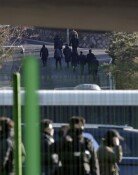[Op-Ed] Chinas High-speed Railway
The Trans-American Railway that opened May 10, 1869, was the result of the pain and sacrifice of Chinese workers. The builder of the railroad faced a labor shortage while constructing the railway linking Sacramento, California, to the U.S. East Coast. The hiring of Chinese workers began in February 1895 under the consideration that the Chinese people had built the Great Wall of China. At the time, many Chinese were living in California due to the Gold Rush. More than 12,000 Chinese were employed to build the section crossing the Sierra Nevada Desert, the biggest challenge in the project. In the process, more than 1,200 Chinese laborers died on the job.
Last year, China accelerated its plan to build high-speed railways despite the outbreak of the global financial crisis. Beijing decided to invest 290 billion U.S. dollars through 2020 to expand its high-speed rail network from just 120 kilometers to 16,000 kilometers. Chinas budget to that end jumped 80.7 percent through November this year from last year. The Beijing-Shanghai line slated for completion in 2012 will cost more than the Three Gorges Dam project on the Yangtze River. Critics say excessive investment in high-speed railways will cut welfare spending, and add that most Chinese cannot afford to use the high-speed trains. This could cause a fiscal crisis for the Chinese government.
The 1,069 kilometer-long section of the Wuhan-Guangzhou line began test operations Saturday, with trains recording a top speed of 394.2 kilometers per hour, the fastest in the world. The railway has cut the travel time between the two cities from 10 hours to two hours and 46 minutes, effectively making China a smaller place. Beijing is also pushing an ambitious project to link itself to Hong Kong by high-speed rail over the next several years. The plan is to slash travel time from 27 hours to just eight hours.
Beijing had allowed Germany, Canada and Japan to bid for contracts to produce bullet trains, but only Chinese companies were allowed to build the railway beds. In Korea, the countrys first high-speed rail KTX debuted in 2004, and ground was broken Dec. 4 this year to build a Honam (Jeolla provinces) line. The KTX 13 is a new Korean bullet train that can run up to 350 kilometers per hour. Yet the country has never built a high-speed railway abroad or exported bullet trains.
Korea Rail Network Authority merely participated in the inspection of certain sections of the railway bed construction for the Wuhan-Guangzhou line. It is about time Korea start to advance into the global market for high-speed railways, which will expand in the wake of the green growth era.
Editorial Writer Kwon Soon-taek (maypole@donga.com)







